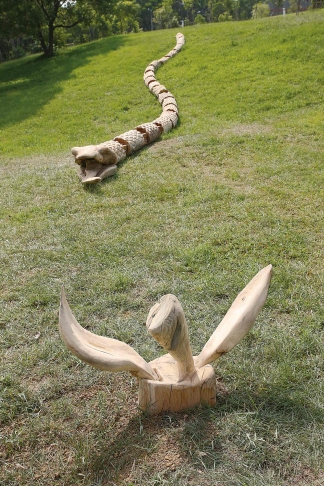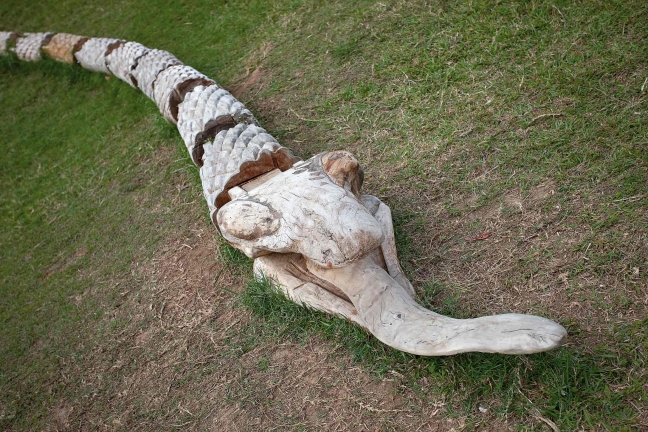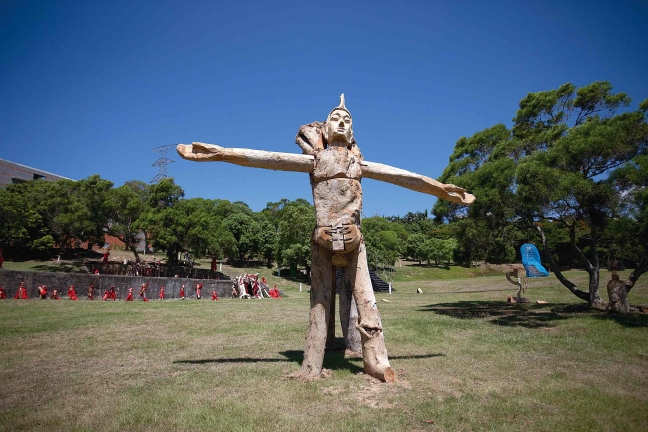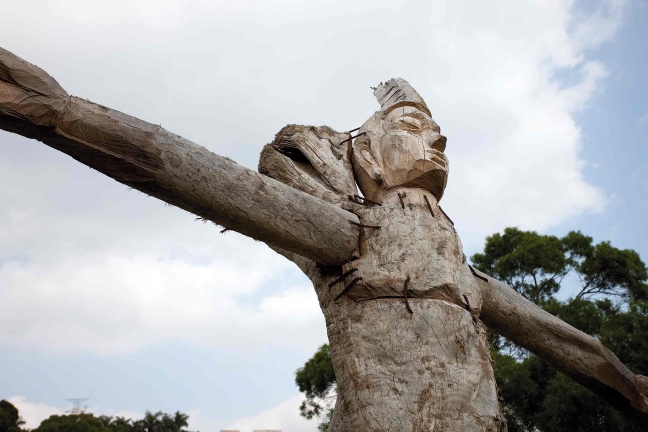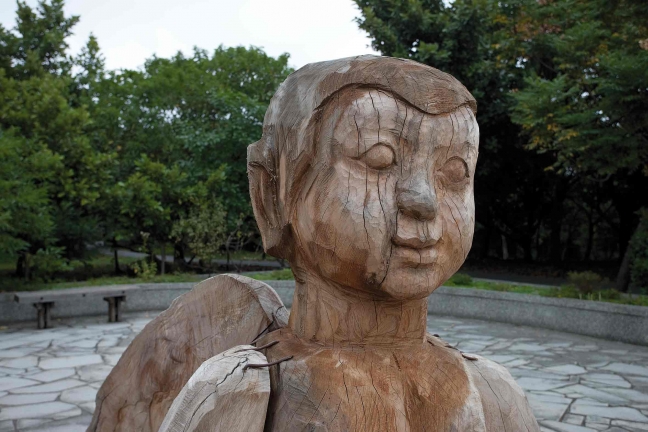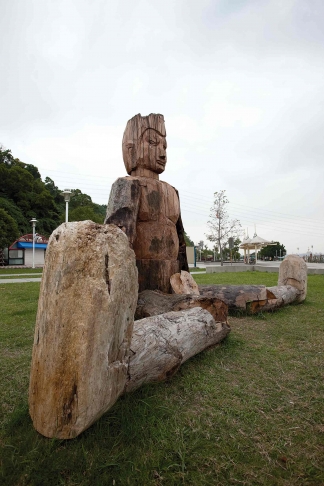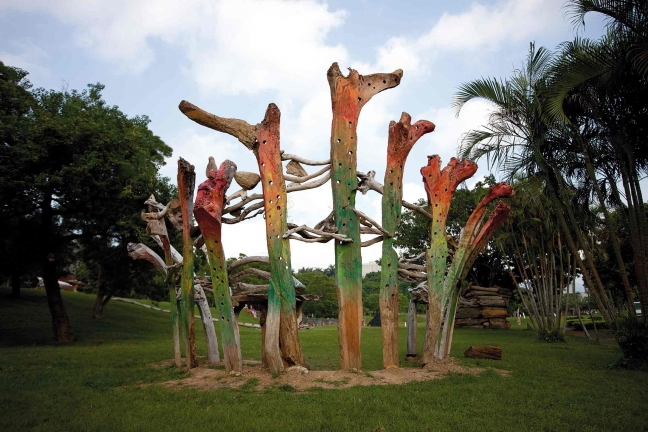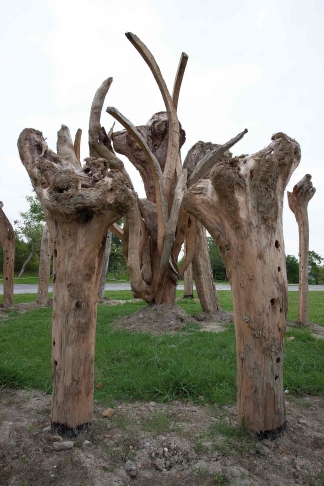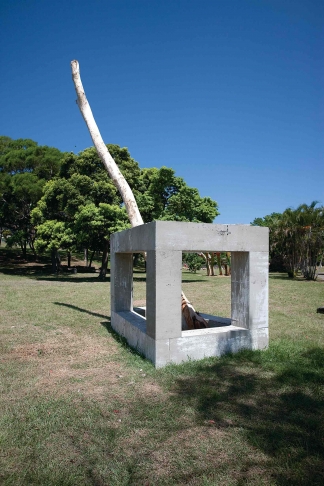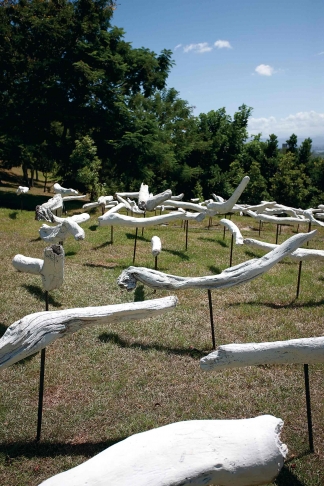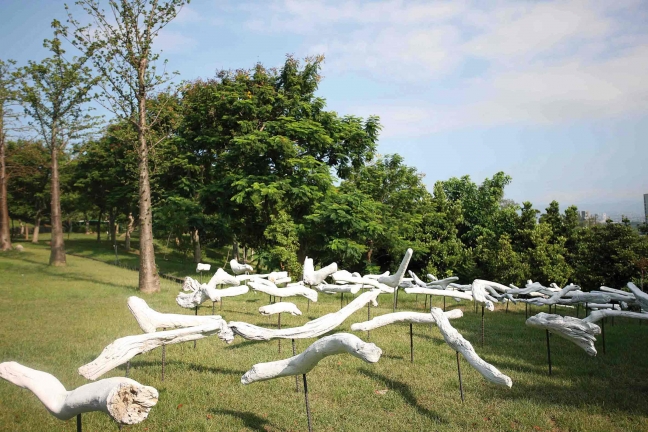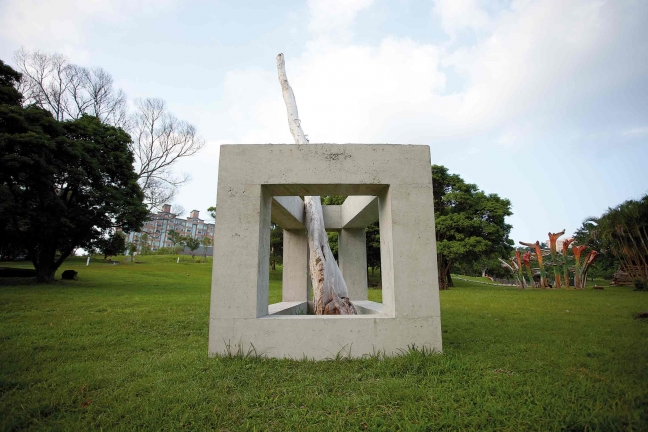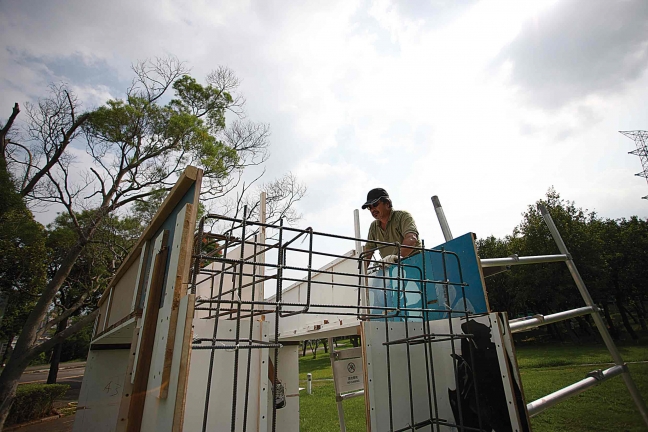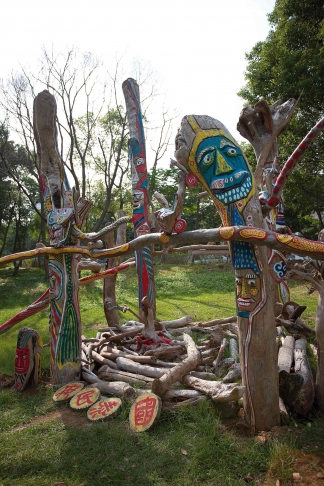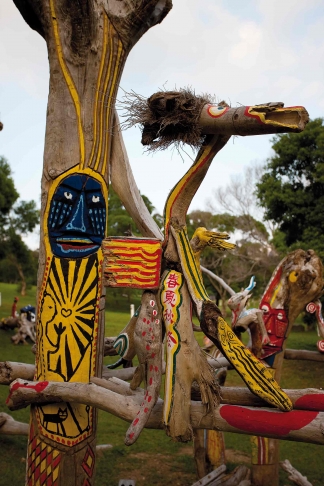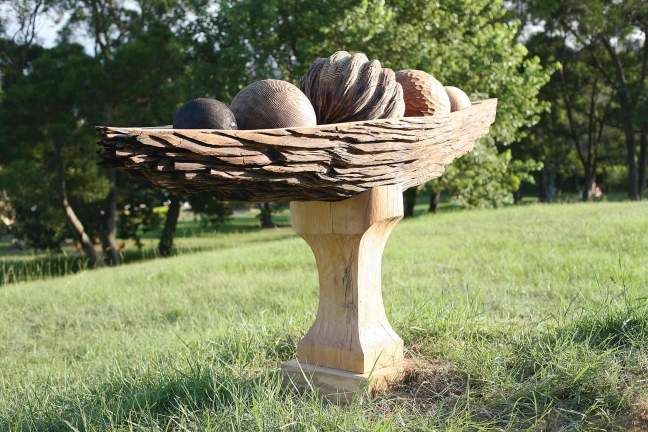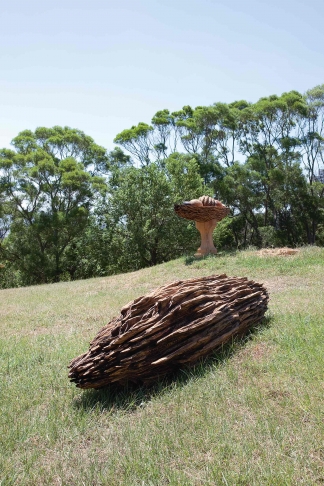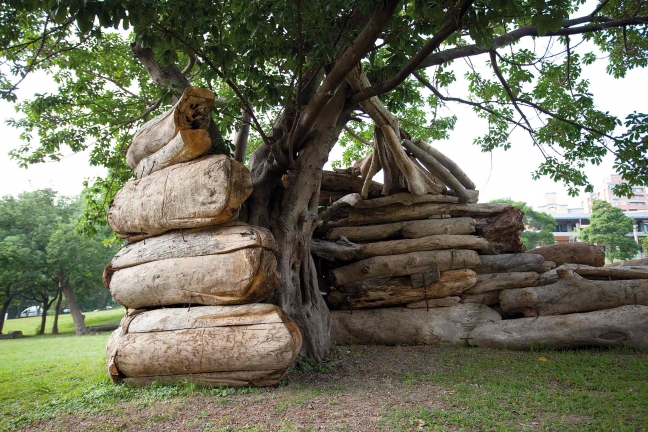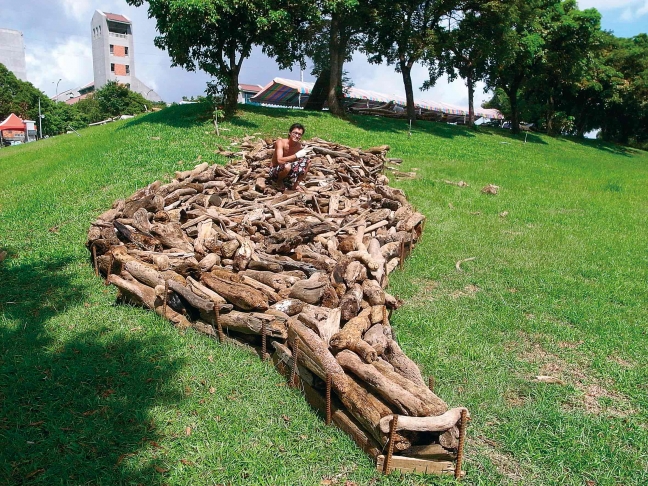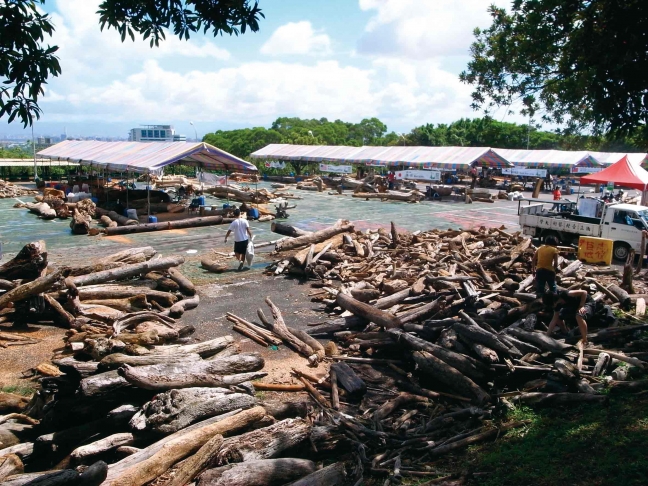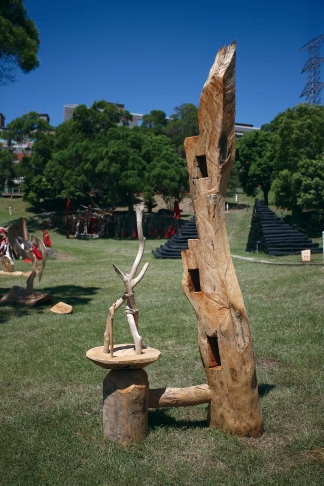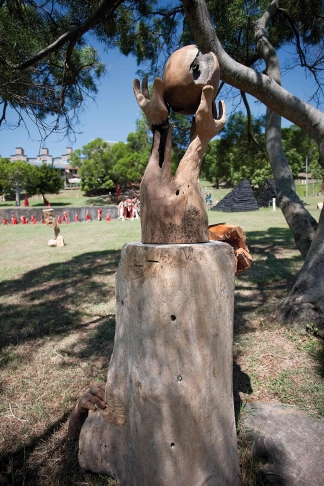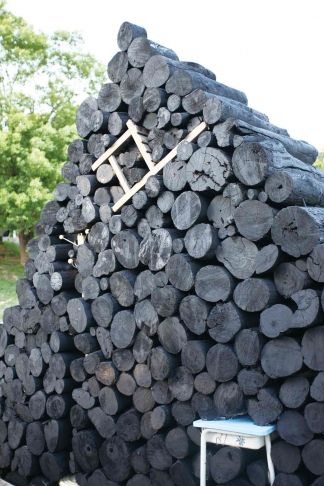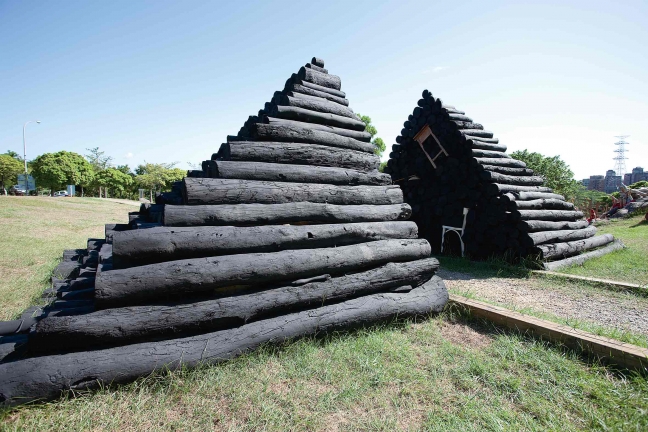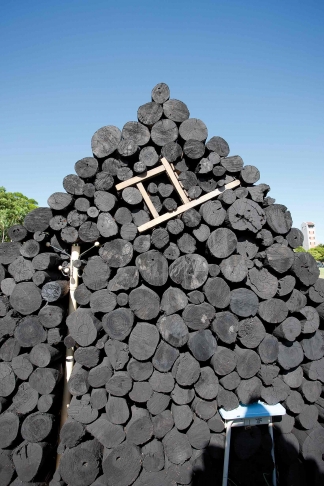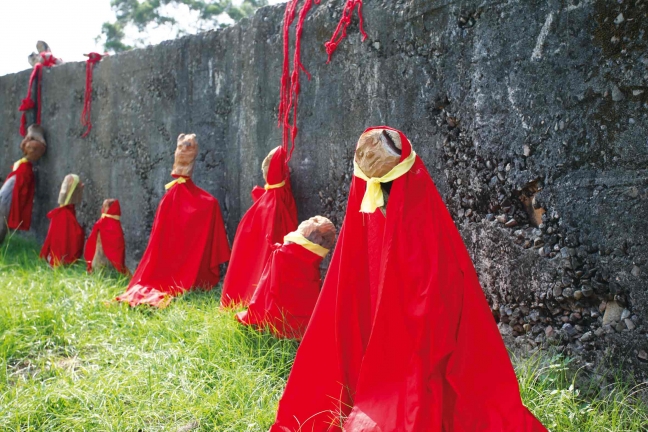Driftwood Sculpture Festival
2009.09.13~2009.12.31
09:00 - 17:00
The Wizard of Oz is a memory shared by many. Its concern with
the way home” points out many readers’ anxiety and expectation about home, which will be fulfilled in the near future.
Dorothy complex” then becomes synonymous with homesickness and symbolic of innocence and courage. Creating in the Aigrette Down, a land teeming with artistic whims and natural auras, the artists will invite people to move their bodies, walk in, and participate in this land of art. They will embark on their own magic journeys, with courage like that of Dorothy, to explore the stories behind each piece of installation art. In terms of the forms with which artists create, some situate their artworks in nature. Some reflect on themselves by extending their personal and internal space to the natural environment. Some travel far back to the ancient times to pursue the mysterious worship for nature. Still some display their romantic sentiments, giving up their statuses as heroes and returning the act of creating to simple natural aesthetics. Nevertheless, the majority of them stress the holistic natural quality of artworks and their relations with nature. Interaction, a main concern of contemporary art, can also be found in all of the works. As people walk into the land and move about these works, they will feel the alternative art vocabulary conveyed by spatial artworks through their different senses. Moreover, the creative spirit of employing nature as a medium and recycling manifests fully the respect for resources.
12 artist groups will launch an imaginative art event in Aigrette Down, Guan-du, with their activism.” This event includes research, communication, lobbying, cooperation, exhibition, and dialogue. It enables cross-over dialogues to structure the conversion of artistic creation and everyday life. Driftwood Sculpture Symposium -Workshop by 12 Artists This is an improvisational art activity, which runs against time and strikes a conversation with the nature. Under the theme of
The Wizard of Oz,” this event explores the wonder of nature, and employs natural resources. Within two weeks, the 12 artists from home and abroad will create a sculpture of no less than 3 cubic metres in volume. Their talents and skills can give new life and meaning to dead driftwood. Above all the others, it is expected to promote knowledge of driftwood and raise the awareness of land preservation. Through reusing the driftwood the artists will add renewable values to it and launch a creative art event at the same time. Where is driftwood from? After a typhoon, massive amounts of uprooted trees and deadwood in the mountains are washed away by floods and landslides to valleys, and then carried by the river currents out to sea. After that, they drift all the way to Taiwan’s northern coastline and, following waves and tides, stack on the seashore. August 8th Flood has caused great pain throughout the island. This nature’s fury warns us to humble ourselves and live harmony with the nature, as well as to devote more attention to land preservation and land security issues. Meanwhile, the grief teaches us how to make better use of mountain resources. This event has obtained permission from Taiwan Forestry Bureau (TFB) under the Council of Agriculture, Executive Yuan and is strongly promoted by Taipei County Government Bureau of Agriculture, and sponsored by the Department of Cultural Affairs, Taipei City Government. All the supports allow us to collect and transport various sizes of driftwood logs along the northern coastline, stretching from Ruifang, Wanli, and Jinshan villages. Driftwood Fun Events The event of
Pray for Victims of August 8th Flood ” will take place in Taipei National University of the Arts. Instead of yellow ribbons, we will use driftwood to deliver our blessings and prayers to the flood victims. Participation from all parties is warmly welcomed. During the weekend of the events, many parent-child activities will be held, including
Driftwood Furniture DIY” and
Driftwood Wind chimes DIY,” where people can learn more about the cycle of relationship between driftwood and the nature with the assistance by artists and experts.
the way home” points out many readers’ anxiety and expectation about home, which will be fulfilled in the near future.
Dorothy complex” then becomes synonymous with homesickness and symbolic of innocence and courage. Creating in the Aigrette Down, a land teeming with artistic whims and natural auras, the artists will invite people to move their bodies, walk in, and participate in this land of art. They will embark on their own magic journeys, with courage like that of Dorothy, to explore the stories behind each piece of installation art. In terms of the forms with which artists create, some situate their artworks in nature. Some reflect on themselves by extending their personal and internal space to the natural environment. Some travel far back to the ancient times to pursue the mysterious worship for nature. Still some display their romantic sentiments, giving up their statuses as heroes and returning the act of creating to simple natural aesthetics. Nevertheless, the majority of them stress the holistic natural quality of artworks and their relations with nature. Interaction, a main concern of contemporary art, can also be found in all of the works. As people walk into the land and move about these works, they will feel the alternative art vocabulary conveyed by spatial artworks through their different senses. Moreover, the creative spirit of employing nature as a medium and recycling manifests fully the respect for resources.
12 artist groups will launch an imaginative art event in Aigrette Down, Guan-du, with their activism.” This event includes research, communication, lobbying, cooperation, exhibition, and dialogue. It enables cross-over dialogues to structure the conversion of artistic creation and everyday life. Driftwood Sculpture Symposium -Workshop by 12 Artists This is an improvisational art activity, which runs against time and strikes a conversation with the nature. Under the theme of
The Wizard of Oz,” this event explores the wonder of nature, and employs natural resources. Within two weeks, the 12 artists from home and abroad will create a sculpture of no less than 3 cubic metres in volume. Their talents and skills can give new life and meaning to dead driftwood. Above all the others, it is expected to promote knowledge of driftwood and raise the awareness of land preservation. Through reusing the driftwood the artists will add renewable values to it and launch a creative art event at the same time. Where is driftwood from? After a typhoon, massive amounts of uprooted trees and deadwood in the mountains are washed away by floods and landslides to valleys, and then carried by the river currents out to sea. After that, they drift all the way to Taiwan’s northern coastline and, following waves and tides, stack on the seashore. August 8th Flood has caused great pain throughout the island. This nature’s fury warns us to humble ourselves and live harmony with the nature, as well as to devote more attention to land preservation and land security issues. Meanwhile, the grief teaches us how to make better use of mountain resources. This event has obtained permission from Taiwan Forestry Bureau (TFB) under the Council of Agriculture, Executive Yuan and is strongly promoted by Taipei County Government Bureau of Agriculture, and sponsored by the Department of Cultural Affairs, Taipei City Government. All the supports allow us to collect and transport various sizes of driftwood logs along the northern coastline, stretching from Ruifang, Wanli, and Jinshan villages. Driftwood Fun Events The event of
Pray for Victims of August 8th Flood ” will take place in Taipei National University of the Arts. Instead of yellow ribbons, we will use driftwood to deliver our blessings and prayers to the flood victims. Participation from all parties is warmly welcomed. During the weekend of the events, many parent-child activities will be held, including
Driftwood Furniture DIY” and
Driftwood Wind chimes DIY,” where people can learn more about the cycle of relationship between driftwood and the nature with the assistance by artists and experts.
The Wizard of Oz is a memory shared by many. Its concern with
the way home” points out many readers’ anxiety and expectation about home, which will be fulfilled in the near future.
Dorothy complex” then becomes synonymous with homesickness and symbolic of innocence and courage. Creating in the Aigrette Down, a land teeming with artistic whims and natural auras, the artists will invite people to move their bodies, walk in, and participate in this land of art. They will embark on their own magic journeys, with courage like that of Dorothy, to explore the stories behind each piece of installation art. In terms of the forms with which artists create, some situate their artworks in nature. Some reflect on themselves by extending their personal and internal space to the natural environment. Some travel far back to the ancient times to pursue the mysterious worship for nature. Still some display their romantic sentiments, giving up their statuses as heroes and returning the act of creating to simple natural aesthetics. Nevertheless, the majority of them stress the holistic natural quality of artworks and their relations with nature. Interaction, a main concern of contemporary art, can also be found in all of the works. As people walk into the land and move about these works, they will feel the alternative art vocabulary conveyed by spatial artworks through their different senses. Moreover, the creative spirit of employing nature as a medium and recycling manifests fully the respect for resources.
12 artist groups will launch an imaginative art event in Aigrette Down, Guan-du, with their activism.” This event includes research, communication, lobbying, cooperation, exhibition, and dialogue. It enables cross-over dialogues to structure the conversion of artistic creation and everyday life. Driftwood Sculpture Symposium -Workshop by 12 Artists This is an improvisational art activity, which runs against time and strikes a conversation with the nature. Under the theme of
The Wizard of Oz,” this event explores the wonder of nature, and employs natural resources. Within two weeks, the 12 artists from home and abroad will create a sculpture of no less than 3 cubic metres in volume. Their talents and skills can give new life and meaning to dead driftwood. Above all the others, it is expected to promote knowledge of driftwood and raise the awareness of land preservation. Through reusing the driftwood the artists will add renewable values to it and launch a creative art event at the same time. Where is driftwood from? After a typhoon, massive amounts of uprooted trees and deadwood in the mountains are washed away by floods and landslides to valleys, and then carried by the river currents out to sea. After that, they drift all the way to Taiwan’s northern coastline and, following waves and tides, stack on the seashore. August 8th Flood has caused great pain throughout the island. This nature’s fury warns us to humble ourselves and live harmony with the nature, as well as to devote more attention to land preservation and land security issues. Meanwhile, the grief teaches us how to make better use of mountain resources. This event has obtained permission from Taiwan Forestry Bureau (TFB) under the Council of Agriculture, Executive Yuan and is strongly promoted by Taipei County Government Bureau of Agriculture, and sponsored by the Department of Cultural Affairs, Taipei City Government. All the supports allow us to collect and transport various sizes of driftwood logs along the northern coastline, stretching from Ruifang, Wanli, and Jinshan villages. Driftwood Fun Events The event of
Pray for Victims of August 8th Flood ” will take place in Taipei National University of the Arts. Instead of yellow ribbons, we will use driftwood to deliver our blessings and prayers to the flood victims. Participation from all parties is warmly welcomed. During the weekend of the events, many parent-child activities will be held, including
Driftwood Furniture DIY” and
Driftwood Wind chimes DIY,” where people can learn more about the cycle of relationship between driftwood and the nature with the assistance by artists and experts.
the way home” points out many readers’ anxiety and expectation about home, which will be fulfilled in the near future.
Dorothy complex” then becomes synonymous with homesickness and symbolic of innocence and courage. Creating in the Aigrette Down, a land teeming with artistic whims and natural auras, the artists will invite people to move their bodies, walk in, and participate in this land of art. They will embark on their own magic journeys, with courage like that of Dorothy, to explore the stories behind each piece of installation art. In terms of the forms with which artists create, some situate their artworks in nature. Some reflect on themselves by extending their personal and internal space to the natural environment. Some travel far back to the ancient times to pursue the mysterious worship for nature. Still some display their romantic sentiments, giving up their statuses as heroes and returning the act of creating to simple natural aesthetics. Nevertheless, the majority of them stress the holistic natural quality of artworks and their relations with nature. Interaction, a main concern of contemporary art, can also be found in all of the works. As people walk into the land and move about these works, they will feel the alternative art vocabulary conveyed by spatial artworks through their different senses. Moreover, the creative spirit of employing nature as a medium and recycling manifests fully the respect for resources.
12 artist groups will launch an imaginative art event in Aigrette Down, Guan-du, with their activism.” This event includes research, communication, lobbying, cooperation, exhibition, and dialogue. It enables cross-over dialogues to structure the conversion of artistic creation and everyday life. Driftwood Sculpture Symposium -Workshop by 12 Artists This is an improvisational art activity, which runs against time and strikes a conversation with the nature. Under the theme of
The Wizard of Oz,” this event explores the wonder of nature, and employs natural resources. Within two weeks, the 12 artists from home and abroad will create a sculpture of no less than 3 cubic metres in volume. Their talents and skills can give new life and meaning to dead driftwood. Above all the others, it is expected to promote knowledge of driftwood and raise the awareness of land preservation. Through reusing the driftwood the artists will add renewable values to it and launch a creative art event at the same time. Where is driftwood from? After a typhoon, massive amounts of uprooted trees and deadwood in the mountains are washed away by floods and landslides to valleys, and then carried by the river currents out to sea. After that, they drift all the way to Taiwan’s northern coastline and, following waves and tides, stack on the seashore. August 8th Flood has caused great pain throughout the island. This nature’s fury warns us to humble ourselves and live harmony with the nature, as well as to devote more attention to land preservation and land security issues. Meanwhile, the grief teaches us how to make better use of mountain resources. This event has obtained permission from Taiwan Forestry Bureau (TFB) under the Council of Agriculture, Executive Yuan and is strongly promoted by Taipei County Government Bureau of Agriculture, and sponsored by the Department of Cultural Affairs, Taipei City Government. All the supports allow us to collect and transport various sizes of driftwood logs along the northern coastline, stretching from Ruifang, Wanli, and Jinshan villages. Driftwood Fun Events The event of
Pray for Victims of August 8th Flood ” will take place in Taipei National University of the Arts. Instead of yellow ribbons, we will use driftwood to deliver our blessings and prayers to the flood victims. Participation from all parties is warmly welcomed. During the weekend of the events, many parent-child activities will be held, including
Driftwood Furniture DIY” and
Driftwood Wind chimes DIY,” where people can learn more about the cycle of relationship between driftwood and the nature with the assistance by artists and experts.
1981 Born in Okayama JAPAN Education 2006 B.F.A in Sculpture Tokyo National University of The Arts 2008 M.F.A in Sculpture Tokyo National University of The Arts Exhibitions 2009 Zoku-Zoku-Zoku(Tokyo/JAPAN) 2008 Zoku-Zoku (Tokyo/JAPAN) 2007 Art Summit in Tokyo National University of The Arts (Tokyo/JAPAN) New works from an old studio (Tokyo/JAPAN) 2006 Port (Okayama/JAPAN) roots (Okayama/JAPAN) Beijing-Tokyo Sculpture exchange Exhibition (Tokyo/JAPAN)
1981 Born in Okayama JAPAN Education 2006 B.F.A in Sculpture Tokyo National University of The Arts 2008 M.F.A in Sculpture Tokyo National University of The Arts Exhibitions 2009 Zoku-Zoku-Zoku(Tokyo/JAPAN) 2008 Zoku-Zoku (Tokyo/JAPAN) 2007 Art Summit in Tokyo National University of The Arts (Tokyo/JAPAN) New works from an old studio (Tokyo/JAPAN) 2006 Port (Okayama/JAPAN) roots (Okayama/JAPAN) Beijing-Tokyo Sculpture exchange Exhibition (Tokyo/JAPAN)
1962 Born in Korea Education B.F.A in Sculpture, Ewha Woman's University M.F.A in Sculpture, graduate of Woman's University Exhibition Solo Exhibition 7 times (Seoul Korea & Tokyo Japan) Teaching job 1990~2001 Full Professorship at Kyngil University 2000~2002 Professor Extraordinary at Educational graduate course in Ewha Woman University 2003~2004 Professor Extraordinary at Ewha Woman University Planning 1996 ~ 2008 (present) Wangsan International Art & Culture Festival Head Planner 2005 ~ 2008 (present) Haslla Open Air Museum Symposium Head Planner 2006 ~ 2008 (present) Road Art Planner 2006 ~ 2008 (present) Five senses Art Factory Planner Out Door Space Directing 2000 ~ 2008 (present) Making Haslla Art World Park & Directing Exhibition 2000 ~ 2008 (present) Making Haslla Museum Hotel & Planing 2008 (present) Planing at Project of making Cultural Street in Kangnung City 2008 (present) Design & Planing at University Street in Kangnung City Present Haslla Art World Chief Director Haslla Museum Owner & Curator
1962 Born in Korea Education B.F.A in Sculpture, Ewha Woman's University M.F.A in Sculpture, graduate of Woman's University Exhibition Solo Exhibition 7 times (Seoul Korea & Tokyo Japan) Teaching job 1990~2001 Full Professorship at Kyngil University 2000~2002 Professor Extraordinary at Educational graduate course in Ewha Woman University 2003~2004 Professor Extraordinary at Ewha Woman University Planning 1996 ~ 2008 (present) Wangsan International Art & Culture Festival Head Planner 2005 ~ 2008 (present) Haslla Open Air Museum Symposium Head Planner 2006 ~ 2008 (present) Road Art Planner 2006 ~ 2008 (present) Five senses Art Factory Planner Out Door Space Directing 2000 ~ 2008 (present) Making Haslla Art World Park & Directing Exhibition 2000 ~ 2008 (present) Making Haslla Museum Hotel & Planing 2008 (present) Planing at Project of making Cultural Street in Kangnung City 2008 (present) Design & Planing at University Street in Kangnung City Present Haslla Art World Chief Director Haslla Museum Owner & Curator
1965 Born in England 1966 Education 1992-3 M. A. Art in Architecture. East London University 1985-7 Diploma in carving and gilding 1983-5 B-tec diploma in wood and stone carving 1983-7 City and Guilds of London Art School Solo Exhibitions(partial) 2008 British Embassy Taipei Guan Xiang Gallery Taipei 2006 National Wood Sculpture Museum. San Yi, Taiwan 2005 Grass Mountain Gallery . Taipei, Taiwan 2004 Burghley Sculpture Garden. UK 2003 20/21 Arts Centre. Scunthorpe, N. Lincs 2000 Finelot Gallery. St. James, London Exhibitions (partial) 2009 Glass Museum, Hsinchu, Taipei 2008 Sun Yat Sen Memorial Hall Taipei 2007 National Wood Sculpture Museum, Taiwan 2006 Taichung Sculpture Association 2005 Capital Gallery. Taipei, Taiwan 2004 Pride of the Valley Sculpture Garden, Surrey World Trade Centre. Taipei, Taiwan 2003 Burghley Sculpture Garden The Gallery at Cork St, London Stamford Arts Centre 2002 Newby Hall Sculpture Park. Yorkshire Beatrice Royal Summer Exhibition. (Hilliers Arboretum) Bircham Contemporary Art Gallery. Norfolk Hart Gallery. London 'Solid State' Burghley Sculpture Garden Sculpture in the Garden. Leicester University
1965 Born in England 1966 Education 1992-3 M. A. Art in Architecture. East London University 1985-7 Diploma in carving and gilding 1983-5 B-tec diploma in wood and stone carving 1983-7 City and Guilds of London Art School Solo Exhibitions(partial) 2008 British Embassy Taipei Guan Xiang Gallery Taipei 2006 National Wood Sculpture Museum. San Yi, Taiwan 2005 Grass Mountain Gallery . Taipei, Taiwan 2004 Burghley Sculpture Garden. UK 2003 20/21 Arts Centre. Scunthorpe, N. Lincs 2000 Finelot Gallery. St. James, London Exhibitions (partial) 2009 Glass Museum, Hsinchu, Taipei 2008 Sun Yat Sen Memorial Hall Taipei 2007 National Wood Sculpture Museum, Taiwan 2006 Taichung Sculpture Association 2005 Capital Gallery. Taipei, Taiwan 2004 Pride of the Valley Sculpture Garden, Surrey World Trade Centre. Taipei, Taiwan 2003 Burghley Sculpture Garden The Gallery at Cork St, London Stamford Arts Centre 2002 Newby Hall Sculpture Park. Yorkshire Beatrice Royal Summer Exhibition. (Hilliers Arboretum) Bircham Contemporary Art Gallery. Norfolk Hart Gallery. London 'Solid State' Burghley Sculpture Garden Sculpture in the Garden. Leicester University
1966 Born in Cincinnati, OH Education 1988 Bachelor of Arts, summa cum laude, distinction in Studio Arts 1987 Studio apprenticeship with Carmen Cicero New York Arts Program – Great Lakes College Association, New York, NY Selected Solo Exhibitions (partial) 2007 Arenas, Cincinnati Art Museum, Cincinnati, OH 2005 Open House, Sapporo Artist-in-Residence (S-AIR), ICC Media Arts Exchange, Sapporo, Japan 2004 Peeps & Bells, Phyllis Weston – Annie Bolling Galleries at M. Willis, Cincinnati, OH Ersilia, Museum of Contemporary Art (MoCA), Taipei, Taiwan Tracings (in Enter/Exit), Taipei Artist Village, Taiwan Selected Group Exhibitions (partial) 2009 Art Chicago, Carl Solway Gallery, Chicago, IL Bridge Art Fair, PAC Gallery, New York, NY The Stars in the Sky Are Still Boss, Reed Gallery University of Cincinnati's College of DAAP Luminal Art, Gallery 100, Taipei, Taiwan 2008 2008 Very Fun Park, Fubon Art Foundation, Taipei, Taiwan The Distorting Mirror, VT Art Salon, Taipei, Taiwan emptysigns, Taipei Artist Village, Taiwan Contemporary Works by Anthony Luensman and Shawna Guip, Phyllis Weston – Annie Bolling Gallery, Cincinnati, OH 2007 Hot Fun! Vol. 1, New Center for Contemporary Art, Louisville, KY 2006 Taipei: Views & Points, Taipei Fine Arts Museum, Taipei, Taiwan 5th Penghu International Earth Art Festival, Penghu, Taiwan
1966 Born in Cincinnati, OH Education 1988 Bachelor of Arts, summa cum laude, distinction in Studio Arts 1987 Studio apprenticeship with Carmen Cicero New York Arts Program – Great Lakes College Association, New York, NY Selected Solo Exhibitions (partial) 2007 Arenas, Cincinnati Art Museum, Cincinnati, OH 2005 Open House, Sapporo Artist-in-Residence (S-AIR), ICC Media Arts Exchange, Sapporo, Japan 2004 Peeps & Bells, Phyllis Weston – Annie Bolling Galleries at M. Willis, Cincinnati, OH Ersilia, Museum of Contemporary Art (MoCA), Taipei, Taiwan Tracings (in Enter/Exit), Taipei Artist Village, Taiwan Selected Group Exhibitions (partial) 2009 Art Chicago, Carl Solway Gallery, Chicago, IL Bridge Art Fair, PAC Gallery, New York, NY The Stars in the Sky Are Still Boss, Reed Gallery University of Cincinnati's College of DAAP Luminal Art, Gallery 100, Taipei, Taiwan 2008 2008 Very Fun Park, Fubon Art Foundation, Taipei, Taiwan The Distorting Mirror, VT Art Salon, Taipei, Taiwan emptysigns, Taipei Artist Village, Taiwan Contemporary Works by Anthony Luensman and Shawna Guip, Phyllis Weston – Annie Bolling Gallery, Cincinnati, OH 2007 Hot Fun! Vol. 1, New Center for Contemporary Art, Louisville, KY 2006 Taipei: Views & Points, Taipei Fine Arts Museum, Taipei, Taiwan 5th Penghu International Earth Art Festival, Penghu, Taiwan
Text / Chen Chun- Hao Looking down the Kuandu Plain from the Aigrette Down, 12 artist groups are set to explore the wonder of nature and employs natural resources, under the theme of “ The Wizard of Oz.” Lai Chi-Man(黎志文) In this festival, people familiar with Lai’s works can find a similar artistic expression in his driftwood sculptures, which perfectly demonstrate his abstract and austere style. Visitors are best advised to come on a quiet morning or a relaxing holiday to experience his Zen aesthetics, and his unique way of communicating with nature and the environment. He always manages and arranges the materials so well that even heavy stones or gigantic driftwood logs, which require an elevator or a crane to lift them up, can be placed at where he wants them to be as easily as making a sketch on paper. Lai uses and displays materials in the most accurate way while fully demonstrating his ideas of sculpture. One can even analyze and appreciate his abstract works of art according to the simple addition and subtraction. [1] By doing so, abstract thoughts can be provoked and the visitors can enjoy the atmosphere with relish. However, the materials and elements used by Lai imply another layer of reflection. The work “The Ladder,” is a 3 cubic-meter concrete structure placed on the clearing in the woods near the Aigrette Down. Inside the structure, Lai put up a 10-meter high poplar driftwood trunk which heads upwards at 45 degrees, as if it is making an announcement to God. This moist driftwood trunk, uprooted, washed away and carried ashore by the August 8th Flood, stands out distinctively in the clearing because it has pale white bark and has no branches at all. As some aboriginal people put it, “ The trunk is still alive and fresh.” The trunk was broken and has lost all its leaves when it was washed away by floods. It could be seen as the “remain” of our environment where the forest preservation started to deteriorate and by this work Lai tried to encourage people to reflect on the severe environmental problems. Another work “White Egret”, is a collection of several ready-made driftwood logs in shapes that look like open arms. Lai covered the logs with white paint evenly and put them on the slope where one can look down the Kuandu Plain. The driftwood pieces seem exactly like a flock of egrets gliding down the slope, and getting ready to fly toward the sky. Apart from echoing the real egrets beside buffalos on the Kuandu Plain, “White Egret” gives a new life and meaning to those deadwood. Driftwood logs, once regarded as the debris of a disaster, are now painted snow-white and acquire a graceful life. They are considered the very end of the life cycle of trees. But what exactly brings the end to trees? For Lai, perhaps, the occurrence of driftwood itself is a sad disaster, which should be considered carefully, instead of a reason to celebrate. Therefore rather than cutting or carving the driftwood, Lai just left those logs the way they were and put them on the right places. Tsai Ken(蔡根) Tsai has long adopted an open-minded and accordant attitude toward materials for his art works. He often uses materials at his fingertips to convert or maintain their given forms, deconstructing or piecing them together, and produces abstract linear sculptures. His works usually possess a sense of humor. His use of ready-made materials helps keep their earthly properties and thus presents large amount of retro memories or narratives. When facing the driftwood, he emphasizes that he does not see them as materials for art works but allows them to present in their own way through words. He has extended the idea of Shihmen Reservoir International Drift-wood Sculpture Symposium in 2005 to this year’s festival. This time, he goes beyond words, setting up his art installation in public places, creating a scene under the theme of “Blue and Green Camps among Mortals and Fairies.” This work is sarcastic of the fact that our Formosa is deteriorating due to political unrest, and becomes so divided that it is like the fragmented driftwood pieces put together to present the shape of Taiwan. In the middle part of this work, Tsai put up a signboard which reads, ” Taiwan the Formosa.” The signboard is also made up of driftwood and has Chinese characters “He(何)”, meaning “What,” and “Wei(為)”, meaning “Is’, on each side of it. One can read the sign from left to right or vice versa and gets different ideas about doubts and criticism of the current politics. Tsai has created a collage of different materials that comprises the reflection of driftwood issues. When facing the contemporary world and feeling confused, we can find a humorous answer in Tsai’s works. The August 8th Flood may be caused by the wrath and force of nature, but the disaster owes more to human ignorance. For this reason, Tsai does not see driftwood as the material for creating art, but for re-establishing the “dignity” of driftwood. He hopes to speak for the driftwood or even, to criticize the occurrence of the August 8th Flood by assembling those driftwood pieces and delivering messages. What tragedies will the long-term political wrestle bring to the people when natural calamities take place? Yien Chung-Hsian(顏忠賢) Yien extended his usual style of “Soft Sculpture” and “Soft Architectures” in this exhibition, compared driftwood to a misfortune deity and indicated the religious element of this incidence. Yien used to apply all sorts of soft materials including white greige cloths, black plastic bags, cottons threads, and hemp ropes to reconstruct a false scene of a religious worship ritual, even bringing up the idea of “false cultivation” experience. The atmosphere in his work is ghostly and haunting, presenting people’s paradoxical attitude toward deities and demons. Yien has made wooden idols and established a countryside temple under the theme of misfortune deity, and in the way of random wondering. The work presents ridiculous suspicious scenarios in modern society, delivering the idea that all sentient beings wondering around possess Buddha-nature and therefore can attain Buddhahood. The installation is placed on a lifted area in the center of the Aigrette Down, and thus resembles a sanctified altar. He has made use of large driftwood branches and roots to establish a low house as a countryside temple which stands with mountains behind, facing the Taipei basin. The temple is decorated by gatepost couplets woven by red wool yarns. The driftwood itself symbolizes the end of life, or death, in other word, and thus should be honored by using it as the materials to build a temple. Since the driftwood issue stems from human ignorance, people should pay respect to it. Yien used old and dead looking branches, along with bright red cloth which carries strong religious connotations and placed dozens of wooden idols covered with red cloths, creating a religious atmosphere in front of the woods. The work throws an indescribable charm and spiritual force around this area, generating a mysterious power which seems to summon something. The setting looks like a ghost temple or a place where spirit mediums dance. It is a piece of successful work, regarding its religious effect, but also brings forward some contentious issues about religions. Some visitors describe it as a ghost temple surround by many spirits and thus consider it not auspicious, while others feel free to have a picnic, take pictures and take a rest around the installation, purifying the ghostly atmosphere. That is probably because whenever personal interpretation is brought into public space arts, compromises or a seesaw battle will emerge, which could result in a revelation of dark, gloomy folklores or an inspiration of innocent fables in our everyday lives. Chang Nai-Wen(張乃文) If we compare Chang’s large wooden driftwood works in this festival with his recent rock sculptures, we can find that they have something in common—the ideas behind both derive from religious stories or mysteries. However, those works are indeed very different in appearance. The reason might be that rock sculptures require long-term effort and hard work. (Therefore it may be called the art of time and efforts.) They need careful consideration and intensive hard work, which will take a long time, but the Driftwood Sculpture Symposium only last two weeks. Because of that, artists involved in the symposium are allowed to create works in a more relaxing manner. This is also why Chang can realize Pinocchio’s dreams. With great talent and perseverance, he completed three pieces of large driftwood sculptures within two weeks. The most eye-catching one is “Punk Centaur,” placed near the path in the middle of the Aigrette Down. It is about 5-meter high and its head and body are made from a 1 diameter Autumn maple tree trunk, and its open hand, from hard briar wood. This work, with a punk head and a gorgeous neck protector, looks like a Centaur walking toward the rainbow on the opening day. It is highly approachable and adds more elements to further connect the exhibition’s substance and its theme. The other work is placed on the open ground in front of the Guangdu Nature Park. This time Pinocchio’s dream is to become this year’s most popular cartoon character, Astro Boy, with a pair of wing on it. It sits quietly beside the plaza of the park and visitors take pictures with it. The last work is a large bodhisattva-like sculpture, placed near the Gwandu Wharf. It sits silently on the grass just as a usual person, watching sunset everyday. When creating those three pieces of works, Chang adopted a simple and implicit way, allowing viewers to have a direct conversation with the works. The sculptures tell stories with their eyes looking at you in a hope to inspire your imagination. Lee Jiun-Yang(李俊陽) Lee, Jiun-Yang, excelling at sculpturing puppet heads, leads a group of volunteers with a common objective to select driftwood and use the image of puppets to create gigantic theatric puppets that can be manipulated on driftwood stage. Lee, based in Taichung, has achieved fame and success in the arts community for
Text / Chen Chun- Hao Looking down the Kuandu Plain from the Aigrette Down, 12 artist groups are set to explore the wonder of nature and employs natural resources, under the theme of “ The Wizard of Oz.” Lai Chi-Man(黎志文) In this festival, people familiar with Lai’s works can find a similar artistic expression in his driftwood sculptures, which perfectly demonstrate his abstract and austere style. Visitors are best advised to come on a quiet morning or a relaxing holiday to experience his Zen aesthetics, and his unique way of communicating with nature and the environment. He always manages and arranges the materials so well that even heavy stones or gigantic driftwood logs, which require an elevator or a crane to lift them up, can be placed at where he wants them to be as easily as making a sketch on paper. Lai uses and displays materials in the most accurate way while fully demonstrating his ideas of sculpture. One can even analyze and appreciate his abstract works of art according to the simple addition and subtraction. [1] By doing so, abstract thoughts can be provoked and the visitors can enjoy the atmosphere with relish. However, the materials and elements used by Lai imply another layer of reflection. The work “The Ladder,” is a 3 cubic-meter concrete structure placed on the clearing in the woods near the Aigrette Down. Inside the structure, Lai put up a 10-meter high poplar driftwood trunk which heads upwards at 45 degrees, as if it is making an announcement to God. This moist driftwood trunk, uprooted, washed away and carried ashore by the August 8th Flood, stands out distinctively in the clearing because it has pale white bark and has no branches at all. As some aboriginal people put it, “ The trunk is still alive and fresh.” The trunk was broken and has lost all its leaves when it was washed away by floods. It could be seen as the “remain” of our environment where the forest preservation started to deteriorate and by this work Lai tried to encourage people to reflect on the severe environmental problems. Another work “White Egret”, is a collection of several ready-made driftwood logs in shapes that look like open arms. Lai covered the logs with white paint evenly and put them on the slope where one can look down the Kuandu Plain. The driftwood pieces seem exactly like a flock of egrets gliding down the slope, and getting ready to fly toward the sky. Apart from echoing the real egrets beside buffalos on the Kuandu Plain, “White Egret” gives a new life and meaning to those deadwood. Driftwood logs, once regarded as the debris of a disaster, are now painted snow-white and acquire a graceful life. They are considered the very end of the life cycle of trees. But what exactly brings the end to trees? For Lai, perhaps, the occurrence of driftwood itself is a sad disaster, which should be considered carefully, instead of a reason to celebrate. Therefore rather than cutting or carving the driftwood, Lai just left those logs the way they were and put them on the right places. Tsai Ken(蔡根) Tsai has long adopted an open-minded and accordant attitude toward materials for his art works. He often uses materials at his fingertips to convert or maintain their given forms, deconstructing or piecing them together, and produces abstract linear sculptures. His works usually possess a sense of humor. His use of ready-made materials helps keep their earthly properties and thus presents large amount of retro memories or narratives. When facing the driftwood, he emphasizes that he does not see them as materials for art works but allows them to present in their own way through words. He has extended the idea of Shihmen Reservoir International Drift-wood Sculpture Symposium in 2005 to this year’s festival. This time, he goes beyond words, setting up his art installation in public places, creating a scene under the theme of “Blue and Green Camps among Mortals and Fairies.” This work is sarcastic of the fact that our Formosa is deteriorating due to political unrest, and becomes so divided that it is like the fragmented driftwood pieces put together to present the shape of Taiwan. In the middle part of this work, Tsai put up a signboard which reads, ” Taiwan the Formosa.” The signboard is also made up of driftwood and has Chinese characters “He(何)”, meaning “What,” and “Wei(為)”, meaning “Is’, on each side of it. One can read the sign from left to right or vice versa and gets different ideas about doubts and criticism of the current politics. Tsai has created a collage of different materials that comprises the reflection of driftwood issues. When facing the contemporary world and feeling confused, we can find a humorous answer in Tsai’s works. The August 8th Flood may be caused by the wrath and force of nature, but the disaster owes more to human ignorance. For this reason, Tsai does not see driftwood as the material for creating art, but for re-establishing the “dignity” of driftwood. He hopes to speak for the driftwood or even, to criticize the occurrence of the August 8th Flood by assembling those driftwood pieces and delivering messages. What tragedies will the long-term political wrestle bring to the people when natural calamities take place? Yien Chung-Hsian(顏忠賢) Yien extended his usual style of “Soft Sculpture” and “Soft Architectures” in this exhibition, compared driftwood to a misfortune deity and indicated the religious element of this incidence. Yien used to apply all sorts of soft materials including white greige cloths, black plastic bags, cottons threads, and hemp ropes to reconstruct a false scene of a religious worship ritual, even bringing up the idea of “false cultivation” experience. The atmosphere in his work is ghostly and haunting, presenting people’s paradoxical attitude toward deities and demons. Yien has made wooden idols and established a countryside temple under the theme of misfortune deity, and in the way of random wondering. The work presents ridiculous suspicious scenarios in modern society, delivering the idea that all sentient beings wondering around possess Buddha-nature and therefore can attain Buddhahood. The installation is placed on a lifted area in the center of the Aigrette Down, and thus resembles a sanctified altar. He has made use of large driftwood branches and roots to establish a low house as a countryside temple which stands with mountains behind, facing the Taipei basin. The temple is decorated by gatepost couplets woven by red wool yarns. The driftwood itself symbolizes the end of life, or death, in other word, and thus should be honored by using it as the materials to build a temple. Since the driftwood issue stems from human ignorance, people should pay respect to it. Yien used old and dead looking branches, along with bright red cloth which carries strong religious connotations and placed dozens of wooden idols covered with red cloths, creating a religious atmosphere in front of the woods. The work throws an indescribable charm and spiritual force around this area, generating a mysterious power which seems to summon something. The setting looks like a ghost temple or a place where spirit mediums dance. It is a piece of successful work, regarding its religious effect, but also brings forward some contentious issues about religions. Some visitors describe it as a ghost temple surround by many spirits and thus consider it not auspicious, while others feel free to have a picnic, take pictures and take a rest around the installation, purifying the ghostly atmosphere. That is probably because whenever personal interpretation is brought into public space arts, compromises or a seesaw battle will emerge, which could result in a revelation of dark, gloomy folklores or an inspiration of innocent fables in our everyday lives. Chang Nai-Wen(張乃文) If we compare Chang’s large wooden driftwood works in this festival with his recent rock sculptures, we can find that they have something in common—the ideas behind both derive from religious stories or mysteries. However, those works are indeed very different in appearance. The reason might be that rock sculptures require long-term effort and hard work. (Therefore it may be called the art of time and efforts.) They need careful consideration and intensive hard work, which will take a long time, but the Driftwood Sculpture Symposium only last two weeks. Because of that, artists involved in the symposium are allowed to create works in a more relaxing manner. This is also why Chang can realize Pinocchio’s dreams. With great talent and perseverance, he completed three pieces of large driftwood sculptures within two weeks. The most eye-catching one is “Punk Centaur,” placed near the path in the middle of the Aigrette Down. It is about 5-meter high and its head and body are made from a 1 diameter Autumn maple tree trunk, and its open hand, from hard briar wood. This work, with a punk head and a gorgeous neck protector, looks like a Centaur walking toward the rainbow on the opening day. It is highly approachable and adds more elements to further connect the exhibition’s substance and its theme. The other work is placed on the open ground in front of the Guangdu Nature Park. This time Pinocchio’s dream is to become this year’s most popular cartoon character, Astro Boy, with a pair of wing on it. It sits quietly beside the plaza of the park and visitors take pictures with it. The last work is a large bodhisattva-like sculpture, placed near the Gwandu Wharf. It sits silently on the grass just as a usual person, watching sunset everyday. When creating those three pieces of works, Chang adopted a simple and implicit way, allowing viewers to have a direct conversation with the works. The sculptures tell stories with their eyes looking at you in a hope to inspire your imagination. Lee Jiun-Yang(李俊陽) Lee, Jiun-Yang, excelling at sculpturing puppet heads, leads a group of volunteers with a common objective to select driftwood and use the image of puppets to create gigantic theatric puppets that can be manipulated on driftwood stage. Lee, based in Taichung, has achieved fame and success in the arts community for
